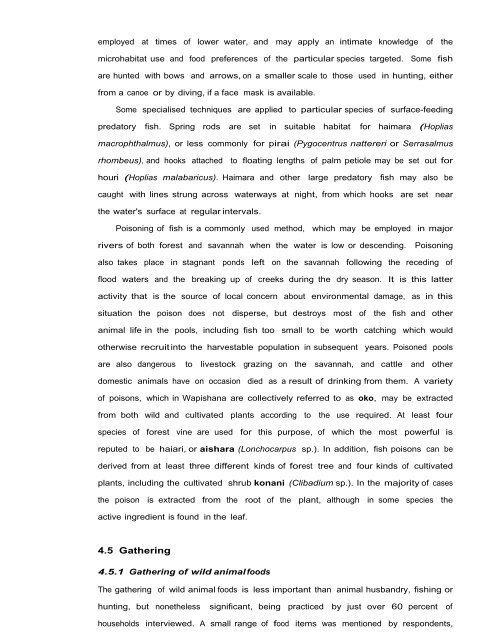Ethnoecology, Resource Use, Conservation And Development In A ...
Ethnoecology, Resource Use, Conservation And Development In A ...
Ethnoecology, Resource Use, Conservation And Development In A ...
You also want an ePaper? Increase the reach of your titles
YUMPU automatically turns print PDFs into web optimized ePapers that Google loves.
employed at times of lower water, and may apply an intimate knowledge of the<br />
microhabitat use and food preferences of the particular species targeted. Some fish<br />
are hunted with bows and arrows, on a smaller scale to those used in hunting, either<br />
from a canoe or by diving, if a face mask is available.<br />
Some specialised techniques are applied to particular species of surface-feeding<br />
predatory fish. Spring rods are set in suitable habitat for haimara (Hoplias<br />
macrophthalmus), or less commonly for pirai (Pygocentrus nattereri or Serrasalmus<br />
rhombeus), and hooks attached to floating lengths of palm petiole may be set out for<br />
houri (Hoplias malabaricus). Haimara and other large predatory fish may also be<br />
caught with lines strung across waterways at night, from which hooks are set near<br />
the water's surface at regular intervals.<br />
Poisoning of fish is a commonly used method, which may be employed in major<br />
rivers of both forest and savannah when the water is low or descending. Poisoning<br />
also takes place in stagnant ponds left on the savannah following the receding of<br />
flood waters and the breaking up of creeks during the dry season. It is this latter<br />
activity that is the source of local concern about environmental damage, as in this<br />
situation the poison does not disperse, but destroys most of the fish and other<br />
animal life in the pools, including fish too small to be worth catching which would<br />
otherwise recruit into the harvestable population in subsequent years. Poisoned pools<br />
are also dangerous to livestock grazing on the savannah, and cattle and other<br />
domestic animals have on occasion died as a result of drinking from them. A variety<br />
of poisons, which in Wapishana are collectively referred to as oko, may be extracted<br />
from both wild and cultivated plants according to the use required. At least four<br />
species of forest vine are used for this purpose, of which the most powerful is<br />
reputed to be haiari, or aishara (Lonchocarpus sp.). <strong>In</strong> addition, fish poisons can be<br />
derived from at least three different kinds of forest tree and four kinds of cultivated<br />
plants, including the cultivated shrub konani (Clibadium sp.). <strong>In</strong> the majority of cases<br />
the poison is extracted from the root of the plant, although in some species the<br />
active ingredient is found in the leaf.<br />
4.5 Gathering<br />
4.5.1 Gathering of wild animal foods<br />
The gathering of wild animal foods is less important than animal husbandry, fishing or<br />
hunting, but nonetheless significant, being practiced by just over 60 percent of<br />
households interviewed. A small range of food items was mentioned by respondents,


